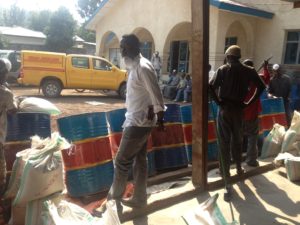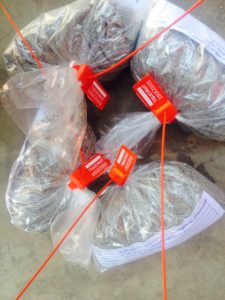COLTAN (COLUMBO–TANTALITE) Ta – Nb

In the early 2000s, tantalum, a rare metal with some unique properties that make it an important raw material for information and communication  technologies. It is among the group of minerals used in the refractory industry, and is characterized by a high melting point and strength at high temperature. These properties make them useful as furnace construction minerals and for application in the aerospace and electronic industries. Despite its high cost, tantalite is more cost effective in many applications, as down time and maintenance costs are reduced. In addition to these valuable properties, tantalum, as a refractory metal, shows remarkable resistance in many of the most hostile chemical environments.
technologies. It is among the group of minerals used in the refractory industry, and is characterized by a high melting point and strength at high temperature. These properties make them useful as furnace construction minerals and for application in the aerospace and electronic industries. Despite its high cost, tantalite is more cost effective in many applications, as down time and maintenance costs are reduced. In addition to these valuable properties, tantalum, as a refractory metal, shows remarkable resistance in many of the most hostile chemical environments.

Columbite, also called Niobite, Niobite-Tantalite and Columbate, is a black mineral group that is an ore of niobium and tantalum. Columbite and tantalite are collectively known as COLTAN in Africa. Tantalum is a valuable rare eleme nt used in electronics manufacturing while Columbite is used in forming alloys that are useful in nuclear, aerospace and gas turbine engineering. Rare-metal pegmatites containing economic concentrations of Columbite-tantalite ore minerals (Coltan) are widespread in Africa.
nt used in electronics manufacturing while Columbite is used in forming alloys that are useful in nuclear, aerospace and gas turbine engineering. Rare-metal pegmatites containing economic concentrations of Columbite-tantalite ore minerals (Coltan) are widespread in Africa.

In 2006, Australia, Brazil, and Canada produced 80% of the world’s coltan, but as mining trends and costs change, so too does the industry’s centers. As of 2012, coltan’s main producers are Australia, Brazil, Canada, Mozambique, and the Democratic Republic of Congo via Rwanda, countries that produce about 66% of the world’s coltan.

During 2009 and 2010, Africa produced more coltan than any other region, with Mozambique and Rwanda alone producing 29% of the world’s coltan in 2010. This was due to the closing of the Wodinga and Greenbushes operations by Global Advanced Metals; these have been reopened in 2011. During the period 2001–2007 the contribution of African countries to coltan production has been hovering around 20%.

Certain regions in Africa have numerous rich coltan deposits and a history of structural and political violence and exploitation. This combination has led to a storied past of human rights violations in the mining industry. Not all African coltan is from conflict zones, however; coltan exists in Egypt, Ethiopia, Nigeria, Namibia, Ghana, and Mozambique, as well as in the DRC. Certain countries have a more flagrant pattern of human rights violations than others, particularly the DRC. The Pan-African (600±150Ma) basement of Nigeria, these pegmatites are also important sources of precious and semiprecious stones (such as beryl, aquamarine, tourmalines).

